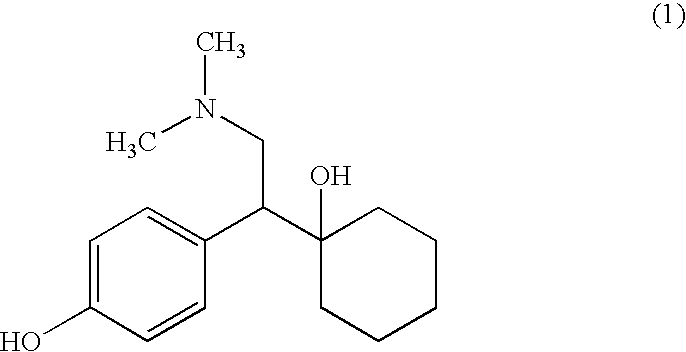Process for making desvenlafaxine
a technology of desvenlafaxine and desvenlafaxine, which is applied in the field of desvenlafaxine making process, can solve the problems of complex demethylation reaction, high concentration of material in solvent, and special reagents for demethylation reaction,
- Summary
- Abstract
- Description
- Claims
- Application Information
AI Technical Summary
Benefits of technology
Problems solved by technology
Method used
Image
Examples
example 1
[0025]A mixture of 5.7 g of sodium sulfide hydrate, and 6 mL of 1-methylpyrrolidone was heated to 145° C. under nitrogen, and then 3.5 g of venlafaxine dissolved in 6 mL of 1-methylpyrrolidone was added. The mixture was stirred and heated at 145° C. under nitrogen, approx. 3.5 g of liquid was distilled off. Reaction mixture was heated at 145° C. for 30 hours, then it was cooled and mixed with 70 mL of ethylacetate and 50 mL of water. The mixture was placed into a refrigerator and after 2 hours crystals were filtered and dried to give 2.5 g of desvenlafaxine.
[0026]Yield 75%.
example 2
[0027]A mixture of 1.90 g of anhydrous sodium sulfide, 2.0 g of selenium and 6 mL of 1-methylpyrrolidone was heated to 145° C. under nitrogen, and then 3.5 g of venlafaxine dissolved in 10 mL of 1-methylpyrrolidone was added. The mixture was stirred and heated at 145° C. under nitrogen. Reaction mixture was heated at 145° C. for 16 hours, then it was cooled and mixed with 70 mL of ethylacetate and 50 mL of water. The mixture was placed into a refrigerator and crystals were filtered. After being recrystallized from 45 mL of ethanol, 2.0 g of desvenlafaxine was obtained with the yield 60%.
example 3
[0028]A mixture of 78.5 g of anhydrous sodium sulfide, and 525 mL of 1-methylpyrrolidone was heated to 145° C. under nitrogen, and then 145 g of venlafaxine was added. The mixture was stirred and heated at 145° C. under nitrogen for 30 hours, then it was cooled and mixed with 2.9 L of ethylacetate and 2.0 L of water. The mixture was kept in the refrigerator overnight, crystals were filtered and dried to give 106.5 g of desvenlafaxine. Yield 77%.
PUM
| Property | Measurement | Unit |
|---|---|---|
| temperature | aaaaa | aaaaa |
| temperature | aaaaa | aaaaa |
| temperature | aaaaa | aaaaa |
Abstract
Description
Claims
Application Information
 Login to View More
Login to View More - R&D
- Intellectual Property
- Life Sciences
- Materials
- Tech Scout
- Unparalleled Data Quality
- Higher Quality Content
- 60% Fewer Hallucinations
Browse by: Latest US Patents, China's latest patents, Technical Efficacy Thesaurus, Application Domain, Technology Topic, Popular Technical Reports.
© 2025 PatSnap. All rights reserved.Legal|Privacy policy|Modern Slavery Act Transparency Statement|Sitemap|About US| Contact US: help@patsnap.com



